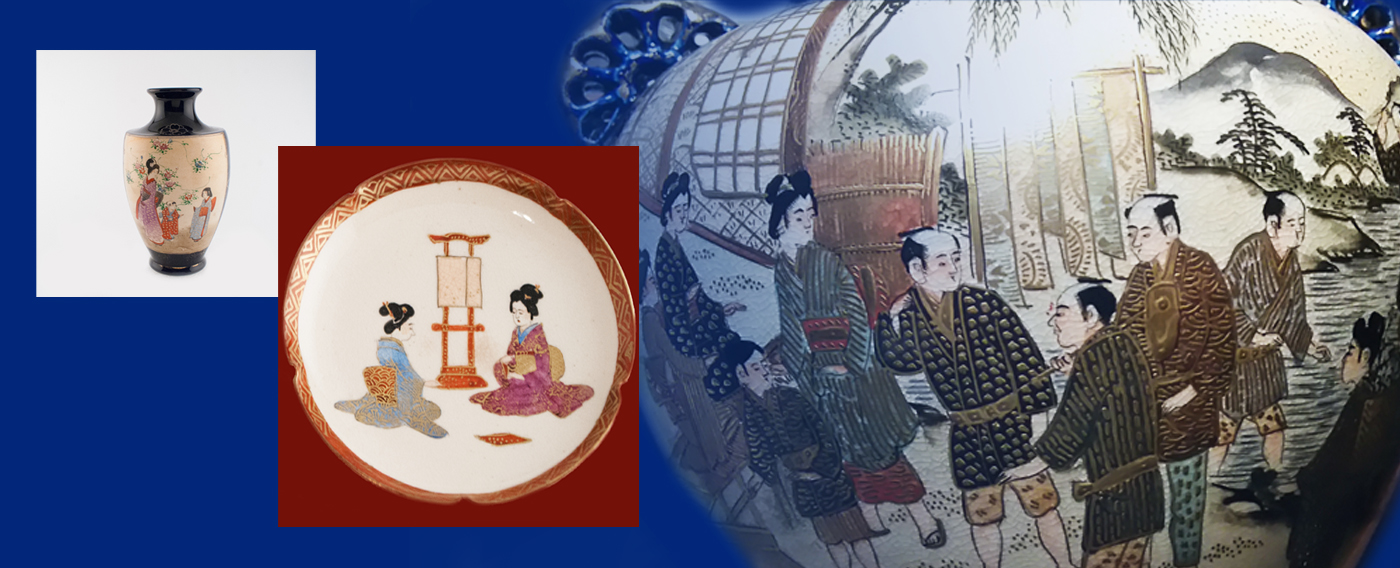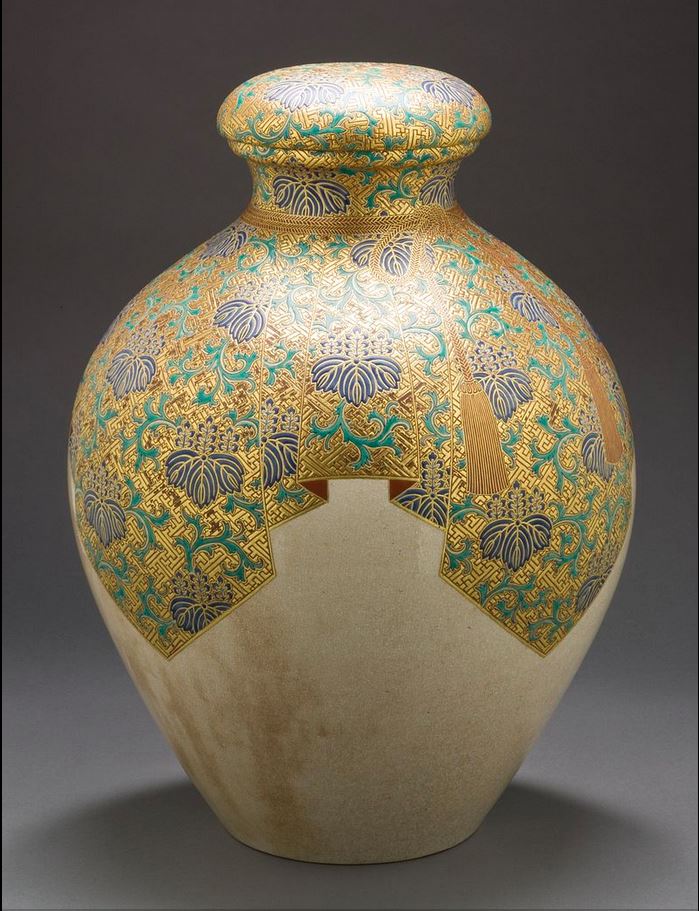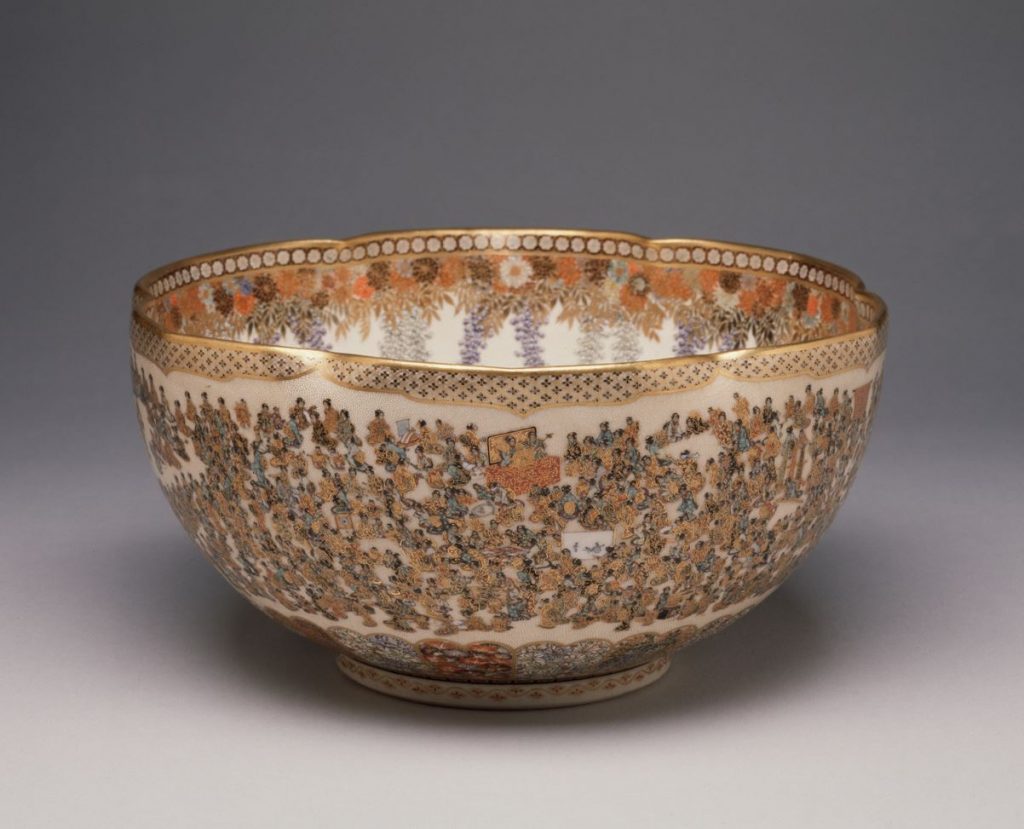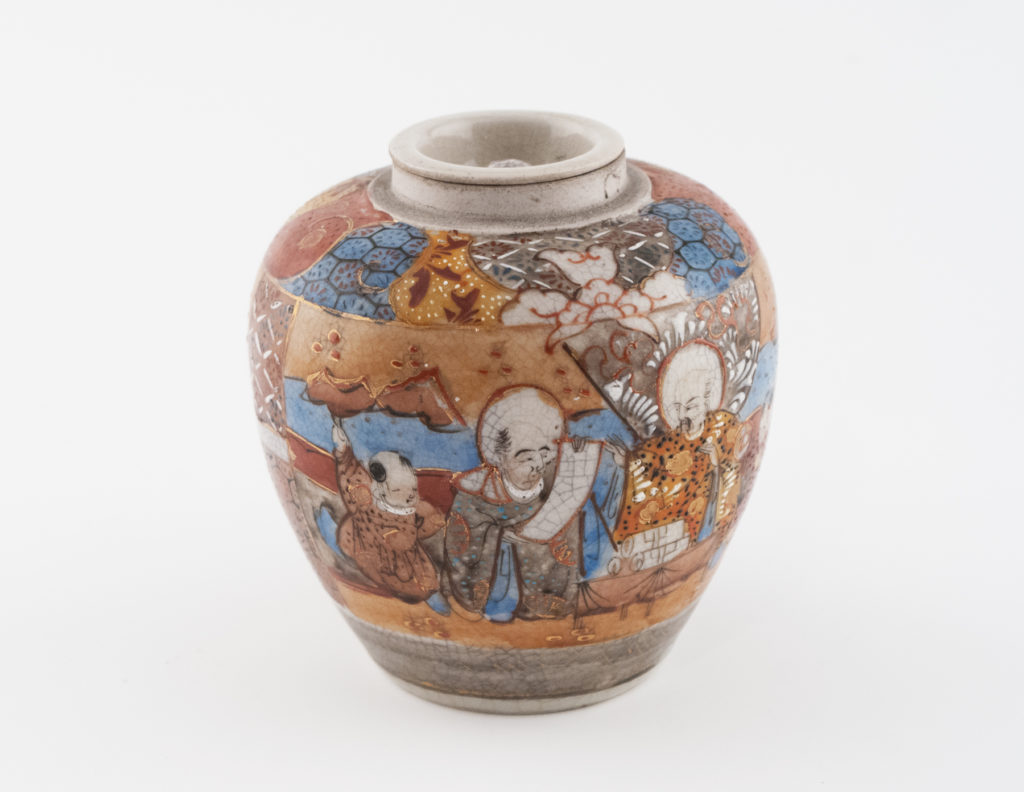
How to collect Satsuma
Following the high demand from the West for Japanese art in the 19th century, there appeared many small and large ceramic factories producing earthenware in Japan.
Satsuma ware were produced in large quantities which flooded European and American export markets and as a result, its quality suffered. This fact probably explains why the majority of Satsuma ware were unmarked.
Satsuma Han originated in the late 16th century in Satsuma province on the south of Kyushu island.
The first stoneware were covered with a thick dark glaze. They were produced by Korean potters who settled on the island. Shimazu mon or the family crest of the ruling clan Satsuma Han appeared on Satsuma ware as a distinctive symbol of this style of Japanese pottery.
High Quality Satsuma
In the second half of 19th century until 1920s , especially during Meiji Period (1868-1912) together with low quality satsuma appeared incredibly elaborate pieces of beauty absolute masterpieces of this type of earthenware.

Satsuma earthenware tea storage jar (chatsubo) with paulownia and thunder pattern, late Edo period, circa 1800-1850 – Japan, late Edo period (1615-1868), circa 1800-1850 Furnishings; Serviceware Satsuma ware; earthenware with overglaze enamels and gold a) Lid height: 2 1/8 in. (5.4 cm); a) Lid diameter: 6 in. (15.24 cm); b) Vase height: 14 3/4 in. (37.47 cm); b) Vase diameter: 13 in. (33.02 cm); Overall height: 16 1/2 in. (41.91 cm); Overall diameter: 13 in. (33.02 cm) Gift of Leslie Prince Salzman (M.2007.130a-b) (https://en.wikipedia.org/wiki/Satsuma_ware#/media/File:Tea_Storage_Jar_with_Paulownia_and_Thunder_Pattern_LACMA_M.2007.130a-b.jpg)
Places where satsuma factories were established included Kagoshima, Kyoto, Tokyo, Osaka, Kobe, Kanazawa, Nagoya, Yokohama.
The most prominent factories were established in Kyoto, Tokyo, Nagoya, Yokohama.
How to identify Satsuma ware.
SATSUMA MARKS
Circled Cross –Shimazu mon – this mark is usually depicted on the top of the main mark and is the family crest of the Satsuma clan.
Often satsuma marks can be painted in gold on the black or red field of a rectangular or square shaped background, sometimes it can be just a painted or be a stamped signature without any background.
Satsuma ware is earthenware type of ceramics, it is not porcelain or fine bone china. It is much thicker and has an ivory, slightly yellowish tint on its glaze. To identify earthenware, look at the chips, which would be beige earthy colour, as opposite to white colour on thinner, Chinese porcelain.
Its ivory tint glaze is usually cracked because of being thinly applied. On the old Satsuma ware glaze cracks would be tiny, sometimes hardly noticeable. They are sign of age being a genuine Satsuma ware produced until 1920s. Later there were made multiple copies of Satsuma, copying the most popular designs but mass produced of much poorer quality.
If you see even cracks on the glaze, large in size, then this would be a modern copy of classical Satsuma ware. The real antique Satsuma glaze would have tiny and uneven cracks, as a result of natural ageing.
Due to the fact that real satsuma is made of earthenware, the rim of a vase’s foot, for example, would be quite thick and the vase itself would have some weight. While choosing Satsuma, always have a proper look at the way it has been painted. Look for details, how well they are depicted. The more intricate details and elaborated design an object would have, more desirable it would be, hence more expensive. Painting on Satsuma ware would often be adorned with golden colours. Gold was usually applied on top of painting, after an item has been fired in the kiln. Because of it, golden decoration is often worn out in time as a result of methodical cleaning.More golden decoration is preserved, more valuable an item can be (taking into account other characteristics, such as age and the name of an artist).
Pricing Satsuma ware.
Unsigned Satsuma ware of 1920s-1930s and of the later periods are now collectable but they are not as expensive as items produced by famous artists. Their price would usually range between £80 -120.
Middle range Satsuma, signed and dated between 1868 -1920 can be more expensive, depending on the quality, amount of guild preserved on the object and how well and detailed it was depicted.
High price command exceptional pieces with very elaborate beautiful painting and signed by a famous Satsuma pottery artist such as Yabu Meizan, Kinkozan, Gyozan or others.

Bowl with a multitude of women, Meiji era, c. 1904, Kinkōzan workshop, by Yabu Meizan.This bowl was decorated by Yabu Meizan at his studio in Osaka. The exterior is decorated with an intricate pattern of hundreds of women engaged in traditional arts, crafts, and cultural practices. They are depicted in multicolored enamels that have been fired onto the bisque surface of this six-lobed foliate bowl. At the base, panels of flowrs ring the bowl. The panels contain approximately twenty identifiable species of flowers including peonies,haydrangea, wisteria, morning glories, three types of camelias, lilies, etc.. The interior features a band of wisteria ringing the rim with blossoms hanging down into the bowl’s interior. Yabu Meizan’s studio would purchase fired bisque stonewares from the Chinjyukan kiln in Kagoshima and from the Kinkozan kiln in Kyoto. They would then transfer designs to the stoneware surfaces from pattern books held in the studio.( https://en.wikipedia.org/wiki/Satsuma_ware#/media/File:Yabu_Meizan_-_Bowl_with_a_Multitude_of_Women_-_Walters_492280_-_Profile.jpg)
Price for masterpieces produced by Yabu Meizan, for example, usually start from £10 000.
We have Satsuma in our Shop

Satsuma Ginger Jar
- USD: $306.10
- EUR: € 254.54
List of the most prominent artists and places of manufacturing Satsuma ware:
Among the artists who produced high quality Satsuma ware were:
- Yabu Meizan (b.1853-d.1934) was one of the best Satsuma artists.
- His works were exceptionally detailed, often pairs of vases. Being one of the most prominent artists of the turn of the 20th century, he was invited to exhibit at the International Exhibition in Paris in 1889. He worked from his studio in Osaka between 1880 and 1926.
- His marks are ypically written or stamped in gold on the read background.
- Kinkōzan: pottery active 1645–1927, headed by Kinkōzan Sōbei; exported heavily from 1875, especially to America; largest overall producer of Satsuma export ware
- Gyozan Sei Zo or Gyozan from Kyoto pottery studio active in Meiji period
- Kozan Zo (1868-1912)
- Koshida: factory active c. 1880–1927; resumed production after 1945
- Chōshūzan: Kyoto workshop active in late Meiji period specializing in dragon ware
- Fuzan: workshop active in Meiji period
Also:
- (1910-20)
- Fuzan (1868-1912)
- Gaho (Meiji period)
- Gyokuzen zo(Late Meiji period)
- Gosuido (early 20th century)
- Gyokuzan (1868-1912)
- Hakuzan – mid 20th century
- Hayakawa (Meiji Period – 1920s)
- Maruni: Kobe manufacturer active until 1938
- Hyozan (Taisho period – 1912-1926)
- Juzan
- Kazan (1912-1926)
- Kitamura Yaichiro
- Kizan
- Koshida company Taiso period
- Makuzu Kozan 1842-1916
- Kyokuzan (1920-1935)
- Taizan/Obi-ya: family-run Kyoto kiln active c. 1673–1922; began exporting in 1872, especially to America
- Yasuda: Kyoto-based company formally known as Yasuda Kyoto Tokiji Goshigaisha, active in Meiji period (https://en.wikipedia.org/wiki/Satsuma_ware).


